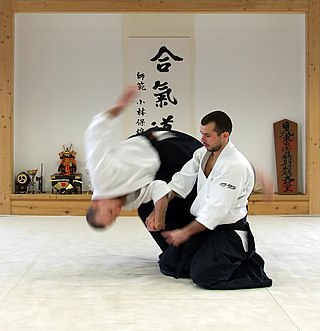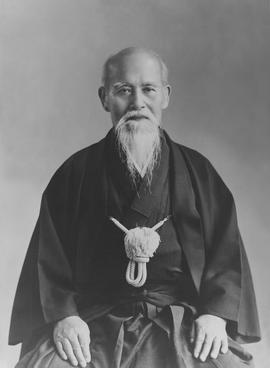
Aikido is a modern Japanese martial art which is split into many different styles including Iwama Ryu, Iwama Shin Shin Aiki Shuren Kai, Shodokan Aikido, Yoshinkan, Renshinkai, Aikikai, and Ki Aikido. Aikido is now practiced in around 140 countries. It was originally developed by Morihei Ueshiba, as a synthesis of his martial studies, philosophy and religious beliefs. Ueshiba's goal was to create an art which practitioners could use to defend themselves while also protecting their attackers from injury. Aikido is often translated as "the way of unifying (with) life energy" or as "the way of harmonious spirit". According to the founder's philosophy, the primary goal in the practice of aikido is to overcome oneself instead of cultivating violence or aggressiveness. Morihei Ueshiba used the phrase masakatsu agatsu katsuhayabi" to refer to this principle.

Morihei Ueshiba was a Japanese martial artist and founder of the martial art of aikido. He is often referred to as "the founder" Kaiso (開祖) or Ōsensei (大先生/翁先生), "Great Teacher".

Daitō-ryū Aiki-jūjutsu, originally called Daitō-ryū Jujutsu, is a Japanese martial art that first became widely known in the early 20th century under the headmastership of Takeda Sōkaku. Takeda had extensive training in several martial arts and referred to the style he taught as "Daitō-ryū". Although the school's traditions claim to extend back centuries in Japanese history there are no known extant records regarding the ryū before Takeda. Whether Takeda is regarded as either the restorer or the founder of the art, the known history of Daitō-ryū begins with him. Takeda's best-known student was Morihei Ueshiba, the founder of Aikido.

Donald Frederick "Donn" Draeger was an American practitioner and teacher of martial arts. He was the author of several important books on Asian martial arts, and was a pioneer of international judo in the United States and Japan. He also helped make the study of martial arts an acceptable topic of academic research.
Kenji Tomiki was a Japanese martial artist who specialized in aikido and judo family of martial arts. He was a pedagogue of martial arts theory. He is the founder of Japan Aikido Association and the competitive aikido style.

Minoru Mochizuki was a Japanese martial artist who founded the dojo Yoseikan. He was a 10th dan in Aikido, 9th dan in Jujutsu, 8th dan in Iaido, 8th dan in Judo, 8th dan in Kobudo, 5th dan in Kendo, 5th dan in Karate, and a 5th dan in Jojutsu.

Yoseikan budō (養正館武道) may be classified as a sōgō budō form, but is used here to indicate a martial art into which various martial ways have been integrated. It is probably most widely known for its descent from a pre-war style of aikido; however, it has important connections to judo, karate, western boxing, savate, and a traditional forms of Japanese combat known as gyokushin-ryū jujutsu and Tenshin Shōden Katori Shintō-ryū.
Tetsuro Nariyama was born in Yamadera, Yamagata Prefecture and is a Japanese aikido teacher, the technical director of the Shodokan Aikido Federation and chief instructor (Shihan) of the Shodokan Hombu Dojo in Osaka, Japan.
Fugakukai International Association, is an organization that promotes the teaching of the martial arts of Kihara aikido, Kodokan judo, and Shindo Muso-ryu jōdō. The name Fugakukai means literally "happy mountain peak association". Currently, Fugakukai dojo are located in the United States with one dojo in Canada.

Hiroshi Tada is a Japanese aikido teacher holding the rank of 9th dan in the Aikikai.
Though the art of aikido is characteristically different from other Japanese martial arts, it has a variety of identifiable styles within the family of organizations descending from the teachings of Morihei Ueshiba.

Hirokazu Kobayashi was a Japanese aikido teacher and student of the founder of aikido Morihei Ueshiba. In 1970, at the age of 41, he was awarded 8th dan rank. He is the initiator of Kobayashi aikido (国際合気道研修会小林裕和派).
Hideo Ohba was a Japanese aikido and judo teacher and the Second Director of Japan Aikido Association after the death of Kenji Tomiki.

Kokusai Budoin, International Martial Arts Federation (IMAF) is the oldest continuously operating Japanese organization promoting international Budō. The organization, founded in 1951, has headquarters in Tokyo, Japan and is a member of the United Nations Department of Economic and Social Affairs.

Shodokan Aikido is the style of Aikido founded by Kenji Tomiki. Shodokan Aikido is sometimes referred to as 合気道競技 meaning "Competitive Aikido" or "Sport Aikido" because of its use of regular competitions.
Shizuo Imaizumi (今泉鎮雄), born 1938) is a Japanese aikido teacher. He holds a rank of 7th dan from the Ki Society, but broke away from the Ki Society in 1987 to found the Shin-Budo Kai style of aikido.
Nobuyoshi Higashi is a Japanese American teacher of Tomiki Aikido, karate, and judo, and the founder of Kokushi-ryu jujutsu. He is a 10th dan in jujutsu, 9th dan in judo, 7th dan in aikido, and 7th dan in karate. His style of aikido includes defenses against knives.

Stanley A. Pranin was an American martial artist, founding publisher, and editor-in-chief of Aikido Journal. Pranin, a researcher and archivist of aikido, has written and published several books and many articles about aikido, Daito-ryu Aikijujutsu, and Morihei Ueshiba and was an influential figure in the aikido world.
Budo Renshu is a technical manual describing 166 techniques of the martial art of aikido. It was written by aikido's founder, Morihei Ueshiba and his student Kenji Tomiki, and illustrated by Takako Kunigoshi.

Jieitaikakutōjutsu is a military self-defence and fighting system developed for JSDF personnel. The system primarily consists of hand-to-hand combat, bayonet and knife fighting principles.











